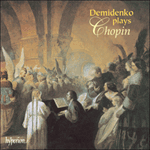
Welcome to Hyperion Records, an independent British classical label devoted to presenting high-quality recordings of music of all styles and from all periods from the twelfth century to the twenty-first.
Hyperion offers both CDs, and downloads in a number of formats. The site is also available in several languages.
Please use the dropdown buttons to set your preferred options, or use the checkbox to accept the defaults.

| Nikolai Demidenko (piano)» More |
In this allegro, Schumann told his readers in the Neue Zeitschrift für Musik, ‘a fine middle melody is wanting, though the cantilena is rich in new and brilliant passages; but it floats past us too restlessly, and we feel the absence of a slow after-movement, an adagio – for the entire plan suggests a complete concerto in three movements. The idea of raising the pianoforte to the highest point of independence possible, and of rendering the orchestra unnecessary, is a favourite one with young composers, and it seems to have influenced Chopin in the publication of his allegro in this form; but this new attempt again proves the difficulty of the task, though it will by no means serve as a warning against future endeavours.’
from notes by Ateş Orga © 1992
extrait des notes rédigées par Ateş Orga © 1992
Français: Alain Midoux
aus dem Begleittext von Ateş Orga © 1992
Deutsch: Anne Steeb/Bernd Müller
 Chopin: Demidenko plays Chopin Chopin: Demidenko plays Chopin‘You will be hard pressed to find playing of such super-fine precision and sensitivity. This is undoubtedly one of the most crystalline and exclusive ... ‘Demidenko's free-flowing virtuosity in such comparitive rarities as the Allegro de concert and Tarantella carries all before it, perfectly off ...» More |

